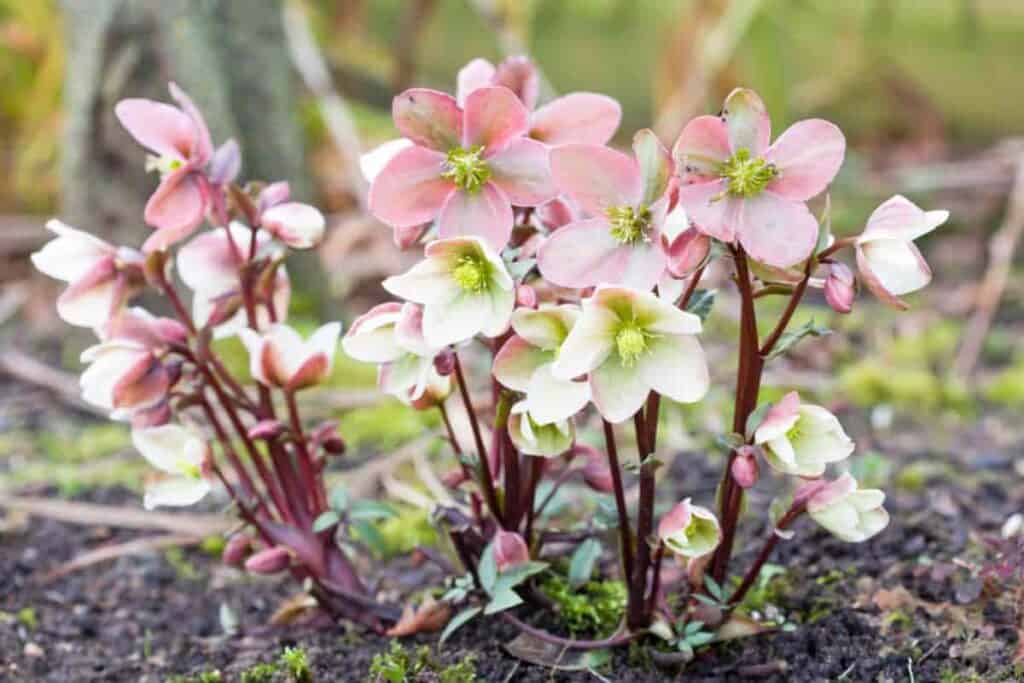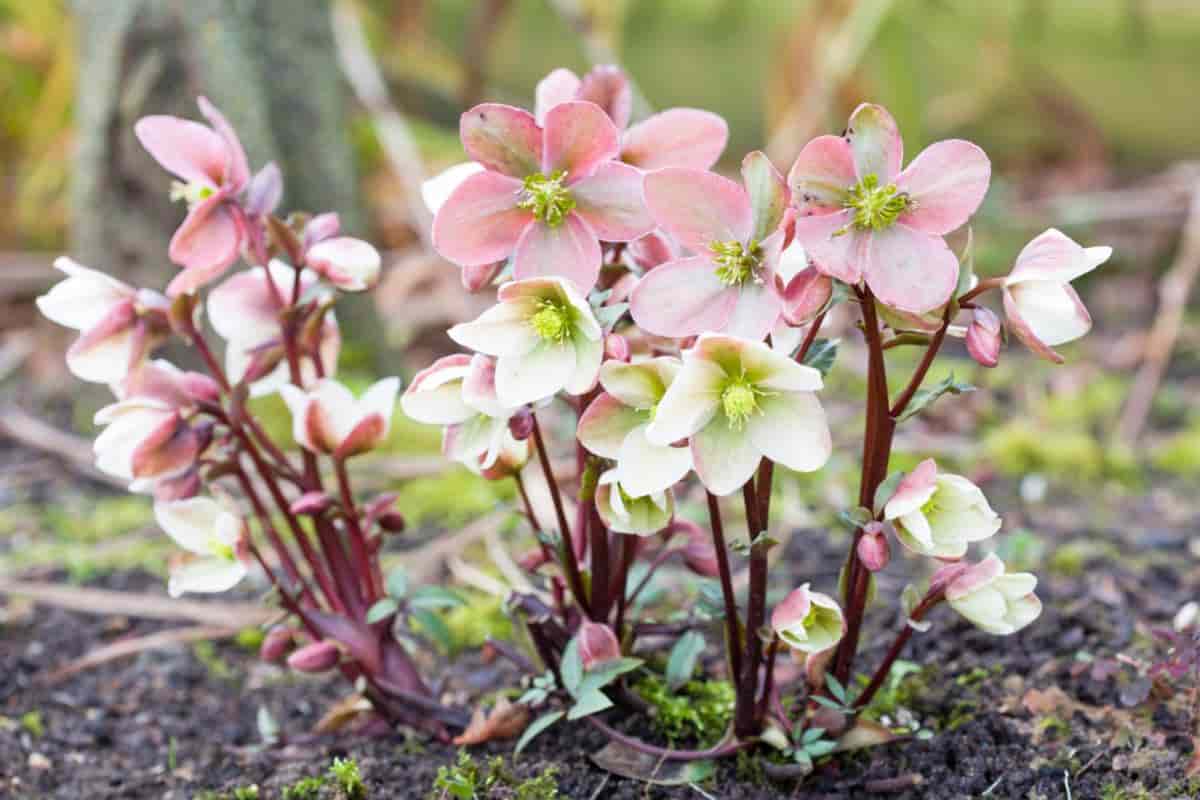Nearly every plant we know is steeped in history, legend, and fable. Some are more fascinating, even more amusing than others, but all have a place in the plant kingdom.
We might think of plants in three divisions: first, those which have a healing quality of medicinal value; second, those which are attractive and have a purpose all their own — of beauty, color, or form; and the third group, those which are harmful to man and beast.

Even these have some redeeming features in the beauty of flower, leaf, color, or form despite the baneful consequences carefully hidden.
The Christmas Rose
Medea, that well-known sorceress of mythological fame, the cause of so much evil, frequently appears in the descriptions of the poisonous plants.
One such plant of late Winter and early Spring is Helleborus, tiger, the name referring to the black roots.
Helleborus, known as the Christmas or Lenten rose, is a very old plant. As the beautiful white-flowered variety blooms or is supposed to bloom at Christmas time, it has been symbolic of that season and called the birthday flower of Christ.
Despite such purity and loveliness, the roots are deadly poisonous and were called “the bread of death” by the ancients.
The leaves of the hellebore are supposed to be able to change a man or woman’s identity, metamorphosing them into a supernatural form from their human character.
Such a transformation took place when a spiritualist or head man of a West African tribe was sent by the powers that be to create the change; in his left hand, he carried a bunch of leaves, and in his right, a club, hellebore leaves were those selected for the purpose.
Even Dogs Don’t Like Them
As spring advances, little splashes of gold appear under the trees as the winter aconite pushes its way up through the damp earth against all odds of ice or snow.
An old-time description tells us: “the aconite is of two kinds, one who kills panthers, and one that kills wolves, one being yellow, one being blue.”
The fern-like leaves of the Winter aconite, like those of their country cousins, the field buttercups, have a poisonous effect.
Medea, that clever sorceress, made a broth or tea of the fruit when she wished to rid herself of her lovers or family member.
The roots of Nepal or Oriental aconite, as with those of the taller blue species known as monkshood, are deadly poison.
In India and China of centuries past, natives would dip their arrowheads into the juice of aconite. The French, ready with a trite idea, called the aconite “kill a dog.” Of course, dogs will not go near the plant, so perhaps that’s the reason.
The first daffodils to open fill our hearts and souls with joy as they are typical of spring. Though the golden trumpets and the pure, white star-shaped flowers are a glory to behold, the juice from the stems and leaves is decidedly poisonous.
Those handling large quantities of these beauties are often very seriously affected, for which there is no known cure at present.
Lilies-of-the-Valley
When gathering a bunch of lilies from the valley in May, how often do we think of other parts of the plant except the flower?
The wide-spreading roots, holding fast in the deep, rich earth, and the berries and the seeds which follow the pure-white bells are poisonous.
The roots have many superstitions attached to them; one is that it is perfectly proper to dig the roots for medicinal purposes.
But to transplant them to another place gives the digger little time in his garden or upon the earth if he does so.
Foliage Injurious to Some
In spring, we look around for the demure primrose so aptly. Namely, they are quaint in their stiff, little leaf-like, green skirts and yellow or rose bodies as they peep up at us from among brown leaves.
To some people, the touch of a leaf is poisonous, which is more keenly felt in the tender or greenhouse kind than those living in the open.
The poison takes the form of a rash (red) that appears on the skin, so it is wiser not to touch or smell the flowers.
If they affect you, the leaves have the power “to change a man,” since the woman is not mentioned, maybe she knows enough not to be hoodwinked.
Fox Gloves And Lupines
Fox gloves, Digitalis purpurea, and lupines produce poisonous seeds and leaves. They are also called dead man’s bells to be heard on stormy evenings as the man walks through the woods, so beware!
Though the cultivated varieties of lupines are not as harmful as those of the fields and plains, the seeds and pods of both kinds should be avoided by children and dogs who sometimes are of an investigating mind as they run through the garden.
It is curious that sheep, who seem to have no instinct that the plant is harmful, insist on nibbling the wild plant, especially the Nebraska lupine, almost immediately after doing so.
The lupine killed fourteen thousand sheep in less than 50 years by the disease called lupinosis.
As one old legend says, “The seed of larkspur, also called larks-heels or larks-toes is thrown before a scorpion or other venomous beast, will either cause them to lose their strength or cloth kill them.”
The garden variety is not as harmful as the wild species of the fields feared by farmers and cattlemen, causing disaster among the herds.
Poppy: Symbolic of Sleep
“The poppies of the garden boiled into the thickness of honey profiteth many griefs; seeds confected with sugar and eaten doth marvelously prevail in procuring the weak patient to sleep soundly.”
So an ancient herbalist tells us. For centuries, the poppy has been symbolic of sleep — in fact, quite a long one.
Its name is supposed to have been derived from the word pap or popping, which was a drink given to children to induce them to sleep. Seeds were ground to a powder for feeding and mixed with milk or soup.
Everyone knows that the oil which is extracted from the poppy seed is the source of the opium trade and of the greater desire for opium smoking, which, in some countries, outweighs the chewing habit.
Wealth Of Gold In August
August brings in a wealth of gold in her cart. Autumn tints the land with red, yellow, and orange at this time.
It is hard to believe, but true that the magnificent Helen of Troy had an herb garden of which she was intensely proud.
She was endowed, so it seems, with the power of magic, and when she stooped to pinch an herb, she would also pinch a serpent or two if he also happened to enjoy the herbs. The great botanist, Pliny, named helenium after the illustrious lady.
The narrow-leafed variety of helenium, which grows wild in humid sections of the country, is deadly poison to both men and cattle, causing convulsions or even death, especially to horses; cows and sheep are not so easily affected, but the wild varieties will much taint the milk of cows.
Pot Herbs
The old-time kitchen garden had its “pot herbs,” among which were tansy, the marigold, and the calendula. They are grown today in our modern herb or flower garden, but not for the same purpose.
Tansy was an old-tune favorite; although the juice of the leaves was used in the celebrated Easter pudding, which did not harm those who partook of the desert, the acrid leaves are highly poisonous to eat.
The custom of having tansy pudding or cake dates back hundreds of years and was a great favorite.
Used As Flavoring
The juice of the pot-marigold calendulas was also used as flavoring. In old-time books, we read that the “herb and flower, of this plant, had great use in cooking, in broths, possets, and drinks which comforted’ the heart”; but, since 1597, when Gerard wrote of the pot-marigold, it was found to be poisonous in its leaves and should not be used “as they smell.”
44659 by Mary Evans
